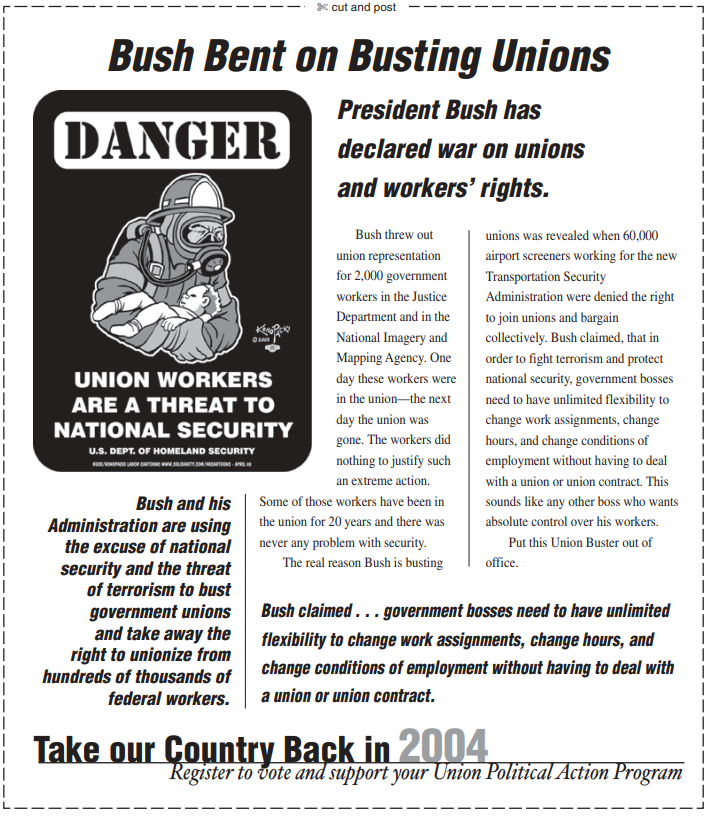Impact on wages and profits
While Bush’s tax-cuts-for-therich solution has failed to produce jobs, it has succeeded in reducing wages. For the year 2003 aggregate wage and salary income has fallen by 0.7 percent. Bush’s cuttaxes-for-the-rich program has proved, for workers at least, to be the equivalent of economic snake oil. But for the owning class, the employers, it’s been more like manna from heaven.
From 2001 through 2003 a total of 58.6 million workers in the U.S. were laid off at some point and about 55 million rehired or were newly hired somewhere. Jobs that were created in the last three years were often not of the same quality as those that disappeared. In addition to lower pay and benefits, they were often temporary, part-time, contractbasis jobs. Various studies show those laid off during this period, and then rehired, went to new jobs that typically paid 30-35 percent less in wages and benefits. A similar study by the Economic Policy Institute in Washington D.C. estimated new hires were earning an average of $14.65 an hour, whereas lost jobs were paying $16.92. The differential is even greater when medical and other benefits are added.
And companies are clearly pocketing the difference. According to recent government data, corporate profits were up by 30 percent in the July-September 2003 period compared to the same period in 2002—the largest year-over-year growth in profits in 19 years and reaching an annual rate of more than $1 trillion dollars for the first time in history. Forecasts are for another 15 percent gain in profits in 2004. That’s a 45 percent raise in just two years.
A lion’s share of the above profits surge accrued to those companies in the U.S. aggressively engaging in moving American jobs offshore. For example, TV business news commentator Lou Dobbs recently compiled a list of 216 companies moving jobs overseas, called the “Dobbs Rogue Fund.” Others have calculated that “these 216 companies registered a remarkable 72 percent return (i.e. profit gain) over the last 12 months.”
True job loss and unemployment
Officially, the number of unemployed during the current Bush recession and jobless recovery that has followed has remained at any given time chronically at around 8-9 million. This does not count the so-called “discouraged workers” leaving the workforce in hundreds of thousands every month, those 5 million employed involuntarily part-time, those involuntarily forced into retirement or those who have no jobs but claim when interviewed to be employed as “consultants” earning an occasional dollar here or there “under the table.”
This alternative, more accurate measure of the unemployed is sometimes called the “labor underutilization rate.” This rate adds about another 2.8 million unemployed for those discouraged. When the discouraged workers, the jobless who want work but drop out of the work force, are added to the official number of those out of work, the unemployment rate in the U.S. is generally around 10 percent, instead of the current official 5-6 percent.
And even this 10 percent of officially unemployed and discouraged doesn’t count those involuntarily employed part time, or forced into retirement, or “consultants” not really working full time by any measurement. The figure for these latter groups would add another 3 million equivalent full time unemployed to the ranks of the jobless at minimum, and another 3-4 percent to the official unemployment rate.
All total that brings the number of those out of work to more than 15 million, and the true unemployment rate to around 13- 14 percent in the U.S. as of early 2004.
Historical parallels
George W. Bush may be the familial offspring of George H. W. Bush, but he is more so the economic policy descendant of Ronald Reagan. George W.’s $2.1 trillion tax cut for the rich is a direct inheritor of Reagan’s similarly targeted tax cuts of $758 billion for the wealthy enacted in the early 1980s.
At that time the $758 billion was a record give away. Just like George W., Reagan’s term was also marked by a more than doubling of defense spending. Similarly, Reagan’s record defense spending and tax cuts resulted in the then-record budget deficits of the 1980s that were used as a hammer by Republicans at the time to attack and cut social spending programs.
—continued on page 8

